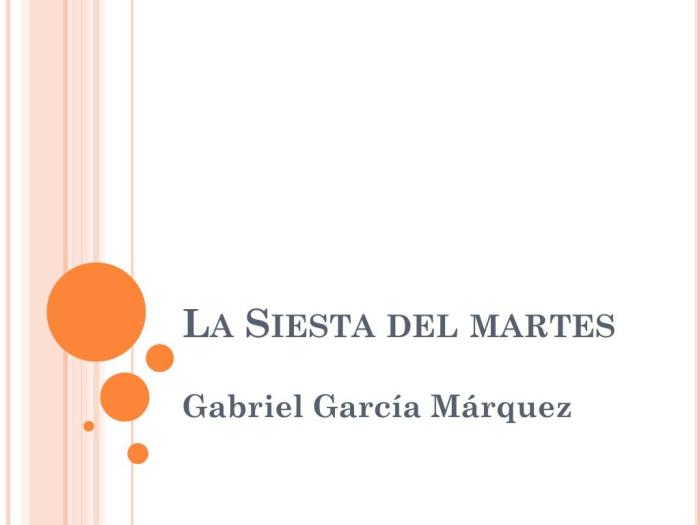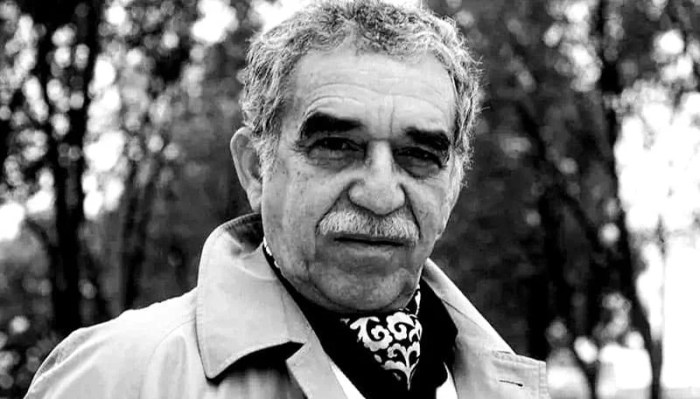La siesta del martes análisis – In the captivating realm of literary analysis, “La Siesta del Martes” emerges as a poignant short story that invites us to delve into a world of intricate relationships, forbidden desires, and the complexities of the human psyche. Join us as we embark on a journey through this literary masterpiece, unraveling its profound symbolism, character dynamics, and social commentary.
Esteban, the story’s enigmatic protagonist, finds himself entangled in a web of deceit and longing. As we dissect his character, we’ll explore the psychological motivations that drive his actions and the consequences he faces. Through the lens of symbolism and recurring motifs, we’ll uncover the hidden meanings woven throughout the narrative, revealing the story’s deeper layers.
Synopsis of ‘La Siesta del Martes’
Gabriel García Márquez’s “La Siesta del Martes” is a short story that follows the life of a young boy named Santiago Nasar, who is fated to be murdered by his friends.
The story takes place in a small town in Colombia and begins with the arrival of Santiago’s former lover, Ángela Vicario. Santiago’s murder is foreshadowed throughout the story, with many characters predicting his death. The main conflict of the story centers around the honor of the Vicario family, which has been tarnished by Santiago’s affair with Ángela.
The theme of the story explores the inevitability of fate and the consequences of one’s actions.
Characters
Santiago Nasar: A young man who is fated to be murdered.
Ángela Vicario: Santiago’s former lover, who accuses him of raping her.
Pedro and Pablo Vicario: Ángela’s brothers, who seek revenge for their sister’s honor.
Father Amador: The town priest, who tries to prevent Santiago’s murder.
Central Conflict
The central conflict of the story is the honor of the Vicario family. When Ángela accuses Santiago of rape, her brothers feel obligated to avenge her honor by killing him. This conflict drives the plot of the story and leads to Santiago’s inevitable death.
Symbolism and Motifs in ‘La Siesta del Martes’
The novella ‘La Siesta del Martes’ is a complex and multifaceted work that employs a rich tapestry of symbols and motifs to convey its themes and explore the inner workings of its characters.
For those who are interested in delving deeper into the intricacies of “La siesta del martes”, I highly recommend checking out the unit 10 circles answer key . This resource provides comprehensive insights and analysis that can further illuminate the themes and symbolism explored in the text.
Returning to “La siesta del martes”, it becomes evident that the exploration of societal norms and expectations is a central thread woven throughout the narrative.
The Siesta as a Symbol of Tranquility and Escape
The siesta, a midday nap, is a recurring motif throughout the novella. It represents a moment of tranquility and escape from the oppressive heat and monotony of everyday life. For the characters, the siesta becomes a refuge from their worries and anxieties.
Colors as Symbols of Emotion and Atmosphere
Colors play a significant role in conveying the emotional and atmospheric landscape of the novella. The bright, vibrant colors of the Mexican countryside contrast with the muted, oppressive tones of the interiors, reflecting the characters’ inner turmoil and the tension between tradition and modernity.
Objects as Symbols of Identity and Memory
Objects, such as the grandmother’s shawl and the father’s watch, serve as powerful symbols of identity and memory. These objects carry emotional weight and connect the characters to their past and their sense of self.
Recurring Motifs of Nature and Time
Nature and time are recurring motifs that underscore the cyclical nature of life and the inevitability of change. The changing seasons, the movement of the sun, and the passage of time remind the characters of their own mortality and the transience of human existence.
Character Analysis: Esteban: La Siesta Del Martes Análisis

Esteban is a complex and enigmatic character in “La Siesta del Martes.” His motivations and actions are often contradictory, making him a fascinating subject of analysis.
Relationships
Esteban’s relationships with his wife and mistress are central to the story. His wife, Maria, is a devout and submissive woman, while his mistress, Alicia, is a passionate and independent artist. Esteban’s inability to fully commit to either woman reveals his own emotional turmoil.
Psychological Effects
Esteban’s actions have a profound psychological impact on him. His guilt over his affair with Alicia leads to insomnia and nightmares. He becomes increasingly isolated and withdrawn, as his inner turmoil consumes him.
Consequences
Esteban’s actions ultimately lead to tragic consequences. His affair is discovered, destroying his marriage and his reputation. He is haunted by the memory of his past actions, and his life spirals out of control.
Social and Cultural Context of ‘La Siesta del Martes’

‘La Siesta del Martes’ reflects the social and cultural landscape of Argentina in the mid-20th century, a time of significant social change and political upheaval. The story provides a glimpse into the norms, values, and challenges faced by Argentine society during this period.
Social Norms and Gender Roles, La siesta del martes análisis
The story highlights the traditional social norms and gender roles that prevailed in Argentine society at the time. Esteban, the protagonist, is a successful businessman who embodies the patriarchal values of his society. He is dominant, assertive, and expects obedience from his wife, Ines.
Ines, on the other hand, conforms to the expected role of a submissive and devoted wife.
Class Dynamics
The story also explores the class dynamics of Argentine society. Esteban and Ines belong to the upper-middle class, which is characterized by wealth and privilege. Their lifestyle and social circle reflect their elevated status. In contrast, the maid, Maria, represents the working class.
Her subservient role and limited opportunities underscore the social hierarchy that existed in Argentina during this period.
Historical Events and Cultural Influences
‘La Siesta del Martes’ was written during a time of political turmoil in Argentina. The country had recently emerged from a period of military dictatorship, and the scars of political violence were still fresh in the minds of many. The story’s exploration of themes such as power, control, and oppression can be seen as a reflection of the political climate of the time.
Literary Techniques and Style
Gabriel García Márquez’s “La Siesta del Martes” employs a range of literary devices and techniques to create a haunting and evocative atmosphere. The story’s fragmented narrative structure, evocative imagery, and stream of consciousness writing style contribute to its surreal and dreamlike quality.
One of the most striking features of the story is its fragmented narrative structure. The story is told in a non-linear fashion, with flashbacks and flashforwards interrupting the present-tense narration. This fragmented structure mirrors the protagonist Esteban’s fractured mental state and disorientation, creating a sense of uncertainty and disquiet.
Foreshadowing
The story also makes use of foreshadowing to create a sense of impending doom. For example, the opening line of the story, “The child had been waiting for the rain for several hours,” suggests that something significant is about to happen.
The child’s anticipation of the rain is a metaphor for Esteban’s own anticipation of his impending death.
Imagery
García Márquez also uses vivid imagery to create a vivid and sensory experience for the reader. The story is filled with images of decay and death, such as the “rotting flowers” and the “corpse-like” appearance of Esteban’s mother. These images create a sense of foreboding and contribute to the story’s overall atmosphere of dread.
Stream of Consciousness
Finally, García Márquez employs a stream of consciousness writing style to capture the inner thoughts and feelings of his characters. This technique allows the reader to experience the characters’ thoughts and emotions directly, creating a sense of intimacy and immediacy.
The stream of consciousness style also contributes to the story’s fragmented and disorienting atmosphere.
Critical Reception and Analysis
Upon its release, ‘La Siesta del Martes’ garnered critical acclaim and sparked extensive literary analysis. The story’s unique narrative structure, exploration of time and memory, and profound symbolism resonated with critics and readers alike, establishing it as a significant contribution to Latin American literature.
One of the most striking aspects of ‘La Siesta del Martes’ is its fragmented and non-linear narrative. Critics have praised García Márquez’s skillful use of flashbacks, foreshadowing, and multiple perspectives to create a complex and immersive reading experience. This fragmented structure mirrors the protagonist’s disjointed memories and the fragmented nature of time itself.
Symbolism and Interpretation
The story’s rich symbolism has also been the subject of extensive analysis. The titular siesta, for instance, is interpreted as a metaphor for both the protagonist’s personal and collective unconscious. Critics have also noted the significance of water and rain, which represent purification, renewal, and the passage of time.
In terms of its meaning and significance, ‘La Siesta del Martes’ has been interpreted in various ways. Some critics view it as an exploration of the cyclical nature of history and the inevitability of death. Others see it as a meditation on the complexities of memory and the fallibility of human perception.
Contribution to Literary Landscape
‘La Siesta del Martes’ is widely considered a masterpiece of Latin American literature and a significant contribution to the genre of magical realism. García Márquez’s unique blend of realism and fantasy, his exploration of time and memory, and his use of vivid imagery have influenced generations of writers and readers.
Clarifying Questions
What is the central conflict in “La Siesta del Martes”?
The central conflict revolves around Esteban’s forbidden affair and the moral dilemmas it presents, leading to a clash between his desires and societal expectations.
How does the use of symbolism contribute to the story’s meaning?
Symbols such as the siesta, colors, and objects serve as metaphors that enrich the narrative, conveying deeper themes and character motivations.
What is the significance of the story’s historical and cultural context?
The story reflects the social norms and gender roles of mid-20th century Argentine society, providing insights into the complexities of the era.
